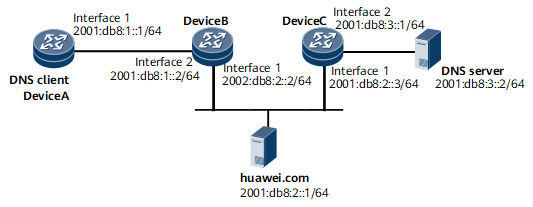Example for Configuring IPv6 DNS
This section provides an example for configuring IPv6 DNS.
Networking Requirements
On the network shown in Figure 1, DeviceA functions as an IPv6 DNS client. To allow DeviceA to use the domain name huawei.com to access the host with the IPv6 address 2001:db8:2::1/64 through an IPv6 DNS server, configure dynamic DNS.
In addition, to allow DeviceA to use the domain name to manage DeviceB and DeviceC, configure static IPv6 DNS entries for DeviceB and DeviceC on DeviceA.
Configuration Roadmap
The configuration roadmap is as follows:
Configure static IPv6 DNS entries.
Enable dynamic DNS.
Specify a DNS server IPv6 address.
Configure a domain name suffix.
Data Preparation
To complete the configuration, you need the following data:
Domain names of DeviceB and DeviceC
DNS server IPv6 address
Domain name suffix
Procedure
- Configure DeviceA.
# Configure static IPv6 DNS entries.
<DeviceA> system-view [~DeviceA] ipv6 host DeviceB 2001:db8:1::2 [*DeviceA] ipv6 host DeviceC 2001:db8:2::3
# Enable dynamic DNS.
[*DeviceA] dns resolve
# Specify a DNS server IPv6 address.
[*DeviceA] dns server ipv6 2001:db8:3::2
# Configure the domain name suffix net.
[*DeviceA] dns domain net
# Configure the domain name suffix com.
[*DeviceA] dns domain com [*DeviceA] commit [~DeviceA] quit

To implement DNS, a route from Device A to the IPv6 DNS server is also required. For details on how to configure routes, see NetEngine 8000 F Configuration Guide - IP Routing.
- Verify the configuration.
# Run the ping ipv6 huawei.com command on DeviceA. The ping operation is successful, and the resolved destination IPv6 address is 2001:db8:2::1.
<DeviceA> ping ipv6 huawei.com Resolved Host ( huawei.com -> 2001:db8:2::1) PING huawei.com : 56 data bytes, press CTRL_C to break Reply from 2001:db8:2::1: bytes=56 Sequence=1 ttl=126 time=6 ms Reply from 2001:db8:2::1: bytes=56 Sequence=2 ttl=126 time=4 ms Reply from 2001:db8:2::1: bytes=56 Sequence=3 ttl=126 time=4 ms Reply from 2001:db8:2::1: bytes=56 Sequence=4 ttl=126 time=4 ms Reply from 2001:db8:2::1: bytes=56 Sequence=5 ttl=126 time=4 ms --- huawei.com ping statistics --- 5 packet(s) transmitted 5 packet(s) received 0.00% packet loss round-trip min/avg/max = 4/4/6 ms# Run the display ipv6 host command on DeviceA. The command output shows the mapping between the host name and IPv6 address in static IPv6 DNS entries.
<DeviceA> display ipv6 host Host Age Flags Address DeviceB 0 static 2001:db8:1::2 DeviceC 0 static 2001:db8:2::3
# Run the display dns ipv6 dynamic-host command on DeviceA. The command output shows dynamic IPv6 DNS entries in the domain name cache.
<DeviceA> display dns ipv6 dynamic-host No Domain Name Ipv6address TTL Alias 1 huawei.com 2001:db8:2::1 3579
The TTL field in the command output shows the lifetime of a dynamic IPv6 DNS entry, expressed in seconds.
Configuration Files
DeviceA configuration file
# sysname DeviceA # ipv6 host DeviceB 2001:db8:1::2 ipv6 host DeviceC 2001:db8:2::3 # dns resolve dns server ipv6 2001:db8:3::2 dns domain net dns domain com # interface GigabitEthernet0/1/0 undo shutdown ipv6 enable ipv6 address 2001:db8:1::1/64 ripng 1 enable # ripng 1 # return
DeviceB configuration file
# sysname DeviceB # interface GigabitEthernet0/1/8 undo shutdown ipv6 enable ipv6 address 2001:db8:2::2/64 ripng 1 enable # interface GigabitEthernet0/1/0 undo shutdown ipv6 enable ipv6 address 2001:db8:1::2/64 ripng 1 enable # ripng 1 # return
DeviceC configuration file
# sysname DeviceC # interface GigabitEthernet0/1/0 undo shutdown ipv6 address 2001:db8:2::3/64 ripng 1 enable # interface GigabitEthernet0/1/8 undo shutdown ipv6 address 2001:db8:3::1/64 ripng 1 enable # ripng 1 # return
